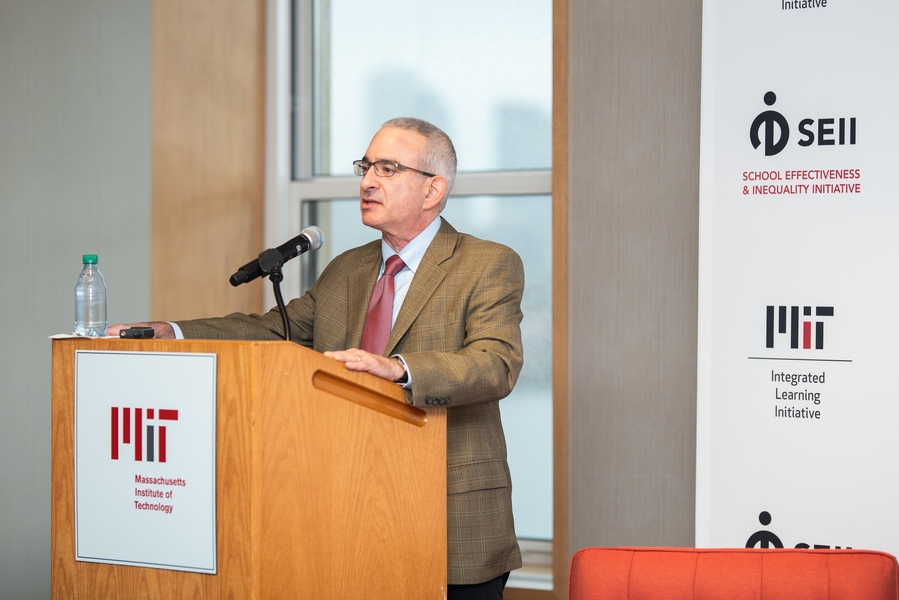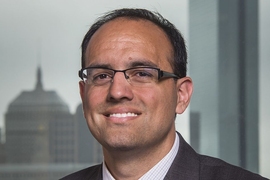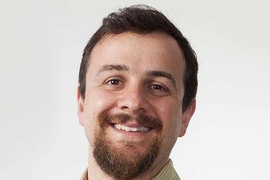Education leaders and scholars from across the country attended the recent MIT School Access and Quality Summit, sponsored by the School Effectiveness and Inequality Initiative (SEII) and the MIT Integrated Learning Initiative (MITili). The conference convened researchers, practitioners, and policymakers to explore school enrollment strategies that increase access and generate data to measure, plan, and improve school effectiveness.
MIT Vice Chancellor Ian Waitz opened the event by comparing the anecdotal approaches educational policymakers and MIT administrators have taken to school improvement in the past.
“Our culture is one where we have a familiarity with teaching and learning, so we tend to rely on anecdotes, rather than rigorous analyses,” Waitz said. “The work you’re all going to consider here is critical to moving forward, and brings rigor to the debate [on school choice and quality].”
He added that the event represented an impressive cross section of education professionals from across the country, including practitioners and researchers from over 25 cities and 16 school districts — including Denver, Grand Rapids, Chicago, Oakland, Memphis, Atlanta, New Orleans, Houston, Providence, Cleveland, New York, and more.
SEII Director and MITili Deputy Director Parag Pathak gave a brief overview of the history of school choice in Boston and New York, then explored how evolving enrollment mechanisms can increase our understanding of school quality. The trend toward centralization, he said, has reduced inefficiency, barriers to access, and unfairness in the school application process. Denver and New Orleans pioneered centralized school choice systems through Unified Enrollment (UE) in 2012, creating a single point for students to choose schools in each city.
Pathak believes there is still plenty of work to do to create “School Assignment 2.0.” SEII, he said, is developing strategies to harness years of enrollment data to facilitate improvement in school quality.
“Choice lives up to potential when [high quality] schools are identified, rewarded, and replicated,” he added.
Fellow SEII Director and Ford Professor of Economics Joshua Angrist built on Parag’s call for data-driven school quality improvement by discussing the flawed methods schools currently use to measure quality. In particular, Angrist stressed the need for schools and parents to disregard the “elite illusion,” which prioritizes peer achievement as the ultimate marker of school quality.
Angrist argued that schools may produce high test scores simply because they accept high-achieving students. Using cutting-edge econometric methods, SEII is able to more accurately assess which schools boost student achievement. In particular, natural experiments found in assignment systems have allowed the team to arrive at sometimes surprising conclusions about school quality.
John Gabrieli, director of MITili and professor in the Department of Brain and Cognitive Sciences, briefly addressed the practitioners in the room. Referencing MITili’s research in cognitive science, data analysis, and policy research in pK-12, higher education, and workplace learning, Gabrieli said: “We don’t want to just do science; we want to do science, engineering, and economics in the work that you do. We want to find a way to interact with the work you do, to make the world better for students.”
Tony Howard III, executive director of enrollment and education Policy for Chicago Public Schools, and Lisa Barrow, senior economist at Federal Reserve Bank of Chicago, shared results discovered after launching GoCPS, a Unified Enrollment system adopted by the Chicago Public Schools. Though findings are still emerging, they said the system has increased transparency and yielded valuable data and insights for CPS policymakers. The adoption of GoCPS was not without its challenges, however. Despite high engagement in its first year, GoCPS’ single-offer system produced some confusion amongst parents and students.
The event keynote speaker, Richard Carranza, chancellor of New York City Department of Education, gave an impassioned speech on the critical need for educational equity. Equality, he argued, was different than equity. Although equality is important, he said, it doesn’t destroy the deeply entrenched power structures of racism that perpetuate intergenerational poverty, incarceration, and homelessness amongst underserved students.
Carranza stressed that more must be done to desegregate America’s public schools. He highlighted the work his own city has been doing — including parent-led plans to remove screened admissions for public elementary and middle schools, putting diversity in admissions plans in place in over 90 schools, and offering universal pre-K throughout the city — and urged policymakers and practitioners to combat implicit bias and apply high expectations to all students.
Carranza told the audience of a young student who told him, “A teacher thought I was smarter than I was, so then I was.”
Like Carranza, Neil Dorosin, executive director of the Institute for Innovation in Public School Choice (IIPSC), stressed the need for community buy-in and infrastructure for parents and underserved communities, through, for example, in-person school information guidance.
Lunchtime workshops highlighted the value of collaboration between practitioners and researchers to advance equity and quality in education. Carrie Conaway, chief research and strategy officer at the Massachusetts Department of Elementary and Secondary Education, opened the session by noting how such collaboration contributes to evidence-informed policymaking "by having conversations with folks within research and practice, you are promoting research use." Then practitioners from across the country shared their policy challenges and engaged in spirited discussion about potential solutions in small groups.
The afternoon sessions featured practitioners and researchers guiding participants through some of the tougher aspects of school choice. Former Camden, New Jersey, superintendent Paymon Rouhanifard called for a fresh look at school accountability incentives, citing the need for better measures of school effectiveness.
The program also focused on such problems as how to allocate seats, how to track school capacity, and how to make choice easy enough for students to apply on their own if needed.
Assistant Professor of Education Policy and Economics at Teacher’s College Sarah Cohodes and Mathematica researchers Steven Glazerman and Dallas Dotter presented studies examining how school information affects enrollment decisions. They were joined by practitioners Claudia Luján and Nadiya Chadha of Washington and New York City, respectively. Tulane Professor Douglas Harris closed the day by reflecting on the conference and prompting the audience to consider several key questions about school choice and quality.
A full list of speakers and more information about the organizations involved can be found at the MIT School Access and Quality Summit website.











